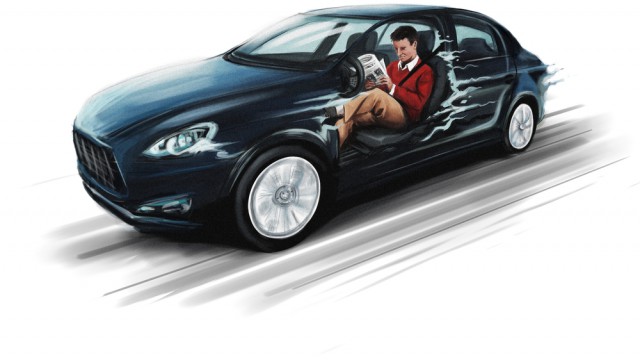How self-driving cars will forever change California's cities

With more than 46,500 miles of interconnected highways and minimally viable public transit in most parts of the state, California is undoubtedly a driving state. This is best evidenced in Southern California, where the freeway system’s notorious traffic and intricacy in design is a daily conversation piece.
A novel concept at the time, California freeways expounded upon the rudimentary expressways that existed in New York, Detroit, and Chicago. What had once been an impromptu system of roads were revamped into streamlined boulevards. Highways were widened and streets were extended. Arteries like the Ramona Boulevard freeway and Hwy 101 linked metropoles to remote locales. Californian’s urban and suburban identity was radically transformed and never looked back.
And now, some 100 years later, cars are likely to transform California’s cities once again -- self-driving cars, that is. Here are some of the prodigious changes we may see and how they could impact the Golden State’s economy.
Slimmer freeways
If you live in the Bay Area, you may have seen Uber test their robot cars (equipped with a rotating LIDAR sensor on the roof), which have been steadily increasing the number of miles driven autonomously. It’s safe to say, this is a harbinger for more to come.
Like the automobile at the turn of the 20th century, mass-market driverless cars will likely impact roadway infrastructure. That’s because current roadways are designed to account for human error. Remove that from the mix and you no longer need spacious lanes, rumble strips, or medians.
The remarkable precision afforded by autonomous technology means a greater number of cars can fit in a smaller amount of space. Imagine the 14-lane 405, a few decades from now, being able to accommodate 20 lanes or more. So, too, would other roadway "obstructions" become obsolete -- including traffic lights, guardrails, signage, and sound walls, since driverless cars are becoming quieter.
Housing opportunities (and the problems therein)
Given the heavy overlay of highway infrastructure, from SoCal to NorCal, that’s a serious amount of real estate suddenly freed up. With a housing crisis in dense Urban areas like San Francisco, Los Angeles, and San Diego, that unused real estate could very well be used for -- you guessed it -- real estate.
Dealing with the housing problem is already a point of controversy among state leaders and experts. Some want to tap into existing unused land for affordable housing developments. Others propose high-density developments in existing cities, along transit corridors and closer to jobs.
The former argues that maximizing unused land can better provide affordable housing. The latter invokes the environmental strain and pollution created by urban sprawl.
But if the issue is mainly maximizing space while providing affordable housing, could driverless cars help close the gap between these opposing views?
The aforementioned removal of highway infrastructure might unlock ample opportunity for housing infill in existing urban and suburban areas. Maximizing space in and around urban centers may help curb sprawl -- but not without a caveat.
A policy brief from the Institute of Transportation Studies at UC Davis warns that automation could actually spur urban sprawl and thereby environmental damage without the right regulations and oversight in place. After all, if dreariness behind the wheel is no longer an issue, then folks are more likely to travel that much farther. That’s an upside for affordable housing, but a downside for our eco-footprint.
There might be other ways, however, that driverless cars could make housing in California more accessible.
Goodbye, parking headaches
If self-driving cars can take folks door to door, then the blood-boiling search for a parking spot may become an afterthought. Not to mention, parking structures as we’ve always know them may be repurposed altogether.
Because cars drive themselves, parking plazas can be moved to city outskirts. Pedestrian amenities like stairs and elevators wouldn’t be necessary. Again, human error is slated to be minimized or eliminated. That could mean slimmer slots, enabling garages to house a greater number of vehicles.
For one, much like the trimming of highway infrastructure, minimizing the need for parking may also make housing more affordable in certain cases. According to the San Francisco Planning Department, parking infrastructure "reduces the amount of housing a parcel can accommodate by as much as 25 percent" and costs $20K to $30K per unit -- the expense of which falls on the tenants. Some experts have even posited that, parking garages could be repurposed as housing developments, thereby reducing construction costs.
Secondly, it can improve the quality of urban life. Research from the Journal of the American Planning Association found that 14 percent of L.A. County alone is devoted to parking infrastructure; imagine if that 14 percent of land were suddenly relinquished for reuse.
Miles-long slabs of concrete could be restored to pedestrian infill. City spaces may be lined with storefronts unimpeded by garages, making them walkable, lively, and safe. More plant life can prosper, air quality may improve, and car-oriented cities like L.A. could become more communal. Likewise, San Francisco, being the second most densely populated city, could get some breathing room.
Not that we ought to just wax fantastic about a utopian future. After all, we’d still need parking garages and charging stations somewhere. And if population growth continues its trajectory, more and more people may end up buying cars, which could, conversely, spur the need for parking garages in some places.
Accidents no more?
Some experts tout the driverless car’s potential to reduce traffic. One of the main contributors to congestion are car crashes, and McKinsey & Co. estimates that self-driving vehicles could eliminate collisions by up to 90 percent.
It’s not just collisions, either. Delayed reactions, too, can cause significant traffic disruptions. All it takes is one driver to see a red tail light, stomp his brake, and cause a succession of drivers behind him to follow suit. The kind of human-prone quirks that arrest traffic would be virtually eliminated by self-driving cars.
Automation enables real-time traffic data so cars can anticipate disturbances ahead. Driverless cars thus move in constant synchronicity. Plus, they don’t have reaction time -- because they don’t need it.
However, some argue autonomous cars will cause congestion in other ways. One major concern posited by UC Davis’ study are zero-occupancy vehicles. Vehicles like these could pick up groceries or packages, which could incidentally compound the number of "zombie cars" on the road. Unless a pricing system is in place, the study argues, people may not be as incentivized to travel with multiple passengers.
There’s also another issue: If something’s cheap, more people will use it. Such is the case for the driverless car, the net effect of which may very well be increased traffic.
Moreover, driverless tech isn’t limited to the passenger car. L.A. is considering a micro-transit system that mimics the ridesharing services of Uber and Lyft but employs vans to pick up more passengers. That sounds promising in the way of traffic reduction, but it also signals other outcomes -- for instance, driverless dump trucks, livery vehicles, city buses, and more. The windfall of savings owed to the discontinuation of drivers could mean more vehicles inundating our roads.
The Unpredicted -- The Unplanned
Probe as we might into the future, there will undoubtedly be unforeseen effects brought on by automation. Remote desert and mountainous cities alike may experience tourist incursions the likes of which we’ve not seen since the introduction of California freeways. Folks might be willing to set digs in towns that’ve never surpassed 1,000 people -- like Bridgeport, Calpine, or Ballico.
Some have even invoked the "Trolley Dilemma" -- a philosophical thought experiment in ethics: Is the self-driving car programmed to protect the driver or the pedestrian?
For example, the brakes give out. You, the driver, are likely to swerve away from a crowd of people, even if it means crashing into a building. But if the self-driving car’s designed to protect you, it may determine -- through myriad data input and algorithms -- that opting toward the now-scrambling crowd is safest for you. Conversely, while most drivers would veer away from the crowd at any cost, most wouldn’t want a self-driving car that could choose to sacrifice the passenger.
For now, though, driverless tech is very much in its infancy. From manufacturers and tech companies to regulatory bodies and the general public, everyone is still learning. What we can confidently say is that self-driving cars are coming, and if any state is crouched at the ready, it’s the Golden State.
 Vannya Kristich is director of product management at Esurance, overseeing profit and growth of personal lines insurance products for the western region of the U.S., including California. Vannya has over 17 years of industry experience, holding product management roles for several major insurance carriers.
Vannya Kristich is director of product management at Esurance, overseeing profit and growth of personal lines insurance products for the western region of the U.S., including California. Vannya has over 17 years of industry experience, holding product management roles for several major insurance carriers.
Photo Credit: LifetimeStock/Shutterstock
